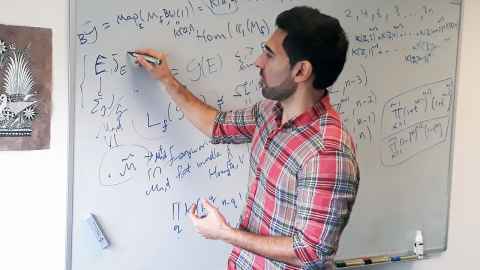Take 10 with... Pedram Hekmati
Dr Pedram Hekmati, senior lecturer in the Department of Mathematics, gives us 10 minutes of his time to discuss geometry, T-duality and being a mathematical detective.

1. Describe your research topic to us in ten words or less.
I am interested in the interaction between geometry and physics.[InSCIde Scoop note: Trust the mathematician to exercise such precision!]
2. Now describe it in everyday terms!
Mathematics and physics have a long history of interaction, with mutual benefit to both fields. My research aims at understanding properties of geometric objects, many of which either arise or are used in models in theoretical physics.
The main tool I use is called an invariant. This is a quantity associated with geometric objects that either (partially) classifies them, or acts as an obstruction to carrying out certain manipulations on them.
The construction of these invariants is a beautiful field of mathematics, and the machinery developed to actually compute them is equally remarkable. My work is focused on constructing and computing such invariants.
3. What are some of the day-to-day research activities you carry out?
I read a lot. This is vital for keeping up with new theories and learning about the latest tools of trait. Occasionally it also offers new ideas or inspiration for tackling a problem.
I carry out computations, mostly by hand, to test my ideas and try to find solutions to research problems that I find interesting, challenging and relevant.
4. What do you enjoy most about your research?
Solving mathematical problems is much like solving a puzzle and involves a lot of ‘detective work’. I greatly enjoy this aspect of my research.
Mathematics is a specific, powerful vocabulary for ideas. Words are handholds that latch onto thoughts, but mathematics brings a clear-cut level of precision to thoughts that I find amazing. [InSCIde Scoop note: We should think of maths as a language with its own coded meaning, rather than thinking about numbers as completely distinct from words… thanks for solving that dilemma, Pedram!]
5. Tell us about something that has surprised you or amused you in the course of your research.
In the process of building models of the real world, physicists stumble upon ingenious constructions that sometimes have powerful applications in pure mathematics. In my own work, I made use of an idea from String Theory called T-duality.
In theoretical physics, T-duality simply means that two particular string theory models are equivalent or ‘T-dual’. Once distilled into a mathematically precise statement, T-duality implicates the equality between invariants of two different geometric objects.
I was able to use this duality to transfer a long and complicated computation of an invariant dating back to the late 1960s, to the computation of an invariant of the T-dual object which ended up being just half a page! This explicit example of the synergy arising from the exchange of ideas between physics and mathematics I find surprising and amusing.
6. How have you approached any challenges you’ve faced in your research?
Dealing with challenges and being stuck on a problem is the nature of research, and this is most certainly the case for pure mathematics.
The whole subject is focused on developing the right concepts, understanding the deep links between them and how they apply to solving problems.
I approach challenges in my research by being persistent; I try to be creative and ‘think outside the box’, and discuss the problems with colleagues and collaborators.
7. What questions have emerged as a result?
One of the beautiful aspects of mathematics is that a solution to a problem typically generates a whole range of new questions. Some could be of the type, ‘Is it possible to generalise a problem by weakening the assumptions?’. Others are the complete opposite, namely, ‘By imposing more conditions, could one prove something much stronger?’.
Another type of question emerges from bizarre coincidences that motivates an investigation into links between different branches of mathematics. Yet another question arises if one notices a certain pattern that could lead to a conjecture.
8. What kind of impact do you hope your research will have?
My hope is that my results will be a relevant contribution to the field of geometry. I would also be pleased if my research is useful in the work of colleagues in both mathematics and physics, for contemporary as well as future generations.
9. If you collaborate across the faculty or University, or even outside the University, who do you work with and how does it benefit your research?
My research is rooted in geometry and mathematical physics, but it is quite wide and interdisciplinary.
This allows me to work with researchers in very different areas of mathematics and physics. I believe this helps my research tremendously, as it offers a bird’s eye view perspective and allows me to transport tools and ideas across different branches of mathematics.
10. What one piece of advice would you give your younger, less experienced research self?
Study hard and remember the famous words of Bertrand Russell: ‘Mathematics, rightly viewed, possesses not only truth, but supreme beauty – a beauty cold and austere, like that of sculpture, without appeal to any part of our weaker nature, without the gorgeous trappings of painting or music, yet sublimely pure, and capable of a stern perfection such as only the greatest art can show.’ [InSCIde Scoop note: We love a side of poetry with our maths – thanks Pedram!]